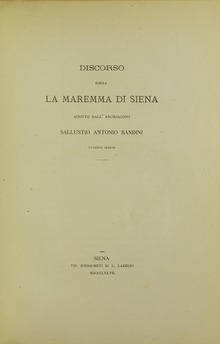Sallustio Bandini
Sallustio Antonio Bandini (born April 19, 1677 in Siena ; † June 8, 1760 ibid) was an Italian archpriest , politician and economist .
Life

Sallustio Antonio Bandini (full name) was born in 1677 as the third child of the married couple Patrizio Bandini and Caterina Piccolomini di Modanella , both from important Senese families, in what is now Via Sallustio Bandini 25 in Siena. He received his first training from the Jesuits , then from the Accademia senese degli Arrischiati . He studied at the University of Siena until 1699, graduating with degrees in philosophy , civil law and canon law . He taught canon law until around 1705 at the Collegio Legale Senese . Around this time he decided to pursue an ecclesiastical career, which he began around 1701 as a candidate for deacons . In 1703 he became a deacon, 1705 a priest , 1708 Canonico metropolitano, 1713 archpriest and 1723 head of the archdeaconate . At that time he was also involved in the Accademia degli Intronati , and his work as a secretary is documented for 1722.
From 1737 to 1739 he wrote his best-known work Discorso sopra la Maremma di Siena ( Discourse on the Senese Maremma ), which, however, was only published posthumously by the Grand Duke of Tuscany, Leopold II . Here he pleaded for free trade in the mostly agricultural goods of the Maremma zone, which should not be hindered by the institution Magistrato dell'Abbondanza in the provincial capital of Siena. The main point of criticism was the Carestia (shortage of goods), which arose from the Siena regulations because, in his opinion, it deterred goods producers. His work seems to be mainly influenced by Pierre Le Pesant de Boisguilbert , whose work Testament Politique de Monsieur de Vauban was found in his library and from which he took arguments against the traditional type of taxation. He's also referring to John Locke . Bandini's theses were sent to Florence around 1739, where they were not found again until around 1771.
In 1758 or 1759 he donated his private library, then comprising 2,886 volumes, to the University of Siena in order to build a university library from which today's Biblioteca comunale degli Intronati (then Biblioteca della Sapienza ) in Via della Sapienza (Street of Knowledge, then still Via degli belle arti - street of fine arts). The donation was subject to the condition that the works must be accessible to the public.
In 1871 the Via dei Miracoli (Street of Miracles) in Siena , where the house where Bandini was born, was renamed Via Sallustio Bandini . In 1880, based on plans by Giuseppe Partini, Tito Sarrocchi created the monument to Sallustio Bandino on the Piazza Salimbeni in front of the Palazzo Salimbeni in Siena.
Works
- Discorso economico (written in 1737 and published in 1775)
- Discorso sopra la Maremma di Siena (created around 1738 and only published posthumously)
- Orazione per l'esaltazione dell'eminentissimo F. Marcantonio Zondanari al grave magistero della sagra ed eminentissima religione gerosolimitana (published in Siena in 1720)
- Sul corso delle monete (created 1718)
literature
- Mario Mirri: BANDINI, Sallustio Antonio. In: Alberto M. Ghisalberti (Ed.): Dizionario Biografico degli Italiani (DBI). Volume 5: Bacca-Baratta. Istituto della Enciclopedia Italiana, Rome 1963.
Web links
Individual evidence
- ↑ Mario Mirri / DBI
- ^ Piero Torriti: Tutta Siena. Contrada per Contrada , Edizioni Bonechi, Florence 2004, ISBN 88-7204-456-1 , p. 259
- ↑ Official website of the Biblioteca comunale degli Intronati on the history of the library, accessed on June 6, 2011 (Ital.) ( Memento of the original of June 11, 2016 in the Internet Archive ) Info: The archive link was inserted automatically and has not yet been checked. Please check the original and archive link according to the instructions and then remove this notice.
- ^ Giuliano Catoni, Maria Merlini, Francesca Ceccherini: I secoli del Monte , Edizioni Alsaba, Siena 2004, p. 70
| personal data | |
|---|---|
| SURNAME | Bandini, Sallustio |
| ALTERNATIVE NAMES | Bandini, Sallustio Antonio (full name) |
| BRIEF DESCRIPTION | Italian archpriest, politician and economist |
| DATE OF BIRTH | April 19, 1677 |
| PLACE OF BIRTH | Siena |
| DATE OF DEATH | June 8, 1760 |
| Place of death | Siena |

